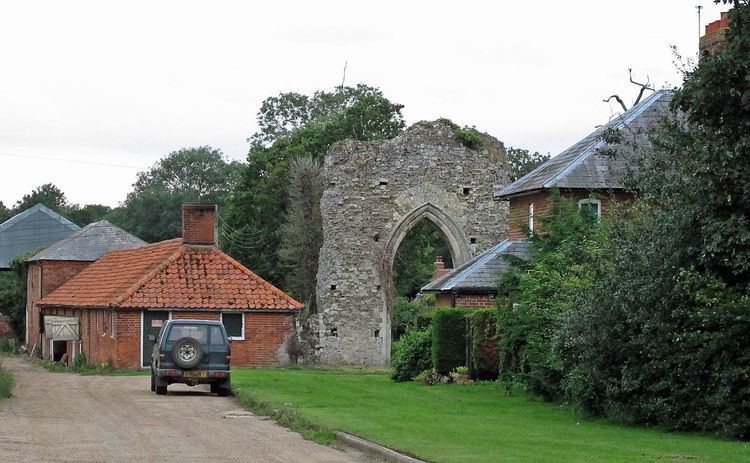Owner Frances Shelley | Phone +44 1394 450046 | |
 | ||
Similar Dairsie Castle, Seckford Hall, Leiston Abbey, Glemham Hall, Hengrave Hall | ||
Butley Priory, sometimes called Butley Abbey, was a medieval monastic house in Butley in Suffolk, England, in the area of the Suffolk Heritage Coast. The only part surviving relatively intact is the very impressive 14th-century gatehouse, which has been in use as a private dwelling for about 280 years. A small fragment of the priory church and some masonry of the former domestic range survives in agricultural use at the adjacent Abbey Farm. The gatehouse is a grade I listed building, and is now used as a venue for private functions, corporate events or retreats.
Contents
Foundation
The Priory, founded in 1171, was the first of two monastic houses planned by Ranulf de Glanvill, (Chief Justice of England to King Henry II), and his wife Bertha, daughter of Theobald de Valoines (from whose estate Campsey Priory was founded in 1195). Ranulf was a military leader on Henry's behalf, mentor to his children Richard and John, and of Hubert Walter, and author of the Tractatus de Legibus. The land chosen for the Priory came from the dowry of Bertha: the foundation coincided exactly with the building of nearby Orford Castle, of which Bartholomew de Glanvill was Constable, and just preceded the Great Revolt, in the suppression of which Ranulf played a conspicuous part. It was founded to be a house of 36 Augustinian canons under a prior, Gilbert, who had been a Precentor at Blythburgh Priory. Ranulf also founded (in 1182) the Premonstratensian abbey at Leiston a few miles north of Butley: he died in 1190 at the Siege of Acre.
The Priory and its gatehouse
Excavations in 1933, conducted by Nowell Myres, revealed that the site comprised a church, chapter house, dormitory, dormitory undercroft, reredorter, refectory, cellarage and store rooms. The church and claustral buildings were on a grand scale. The abbey gatehouse, now known as Butley Priory, was built around 1325 (in the time of prior William de Geyton) and is in itself an arresting structure, substantially original despite various modifications. It has been compared to the surviving gatehouse of Kirkham Priory in Yorkshire. The great eastern gable, flanked by twin towers with large buttresses, presents four tiers. At ground level, now filled with masonry, are the great arch of the vaulted carriage entrance with a smaller arch for pedestrians beside it, surmounted by decorative flint flushwork. At the second level is a stone emblazoning of 35 shields set in chequer fashion in five horizontal rows declaring the distinguished benefactors. The third tier presents three equal arches with tracery with flushwork detailing, and above this in the gable itself are three central niches for figures of the Virgin Mary and other saints. The north and south wings make a central crossing, and there is a corresponding western frontage rich in knapped flint facing work. The stone indent of William de Geyton's funeral monument, apparently removed from the priory church for use as an altar-slab, is preserved at nearby Hollesley church.
Transition to domestic use
A late register or chronicle of the priory survives and is published. The house was troubled by the suicide of its prior Robert Brommer, and in the time of his successor Augustine Rivers (1509-1528) the guesthouse (the gatehouse) was visited by both Charles Brandon, Duke of Suffolk, and by his rival the Duke of Norfolk. It was dissolved in 1538. The monastery site was purchased by William Forth (died 1558) and a large (now lost) house was built by his son Robert adjacent to the gatehouse. This was derelict, and the gatehouse ruinous, by 1738 when illustrated by Samuel and Nathaniel Buck. At that time the priory church tower was still standing. The gatehouse was repaired in brick as a residence by George Wright during the 18th century, and was leased by Arthur Chichester, 1st Marquess of Donegall, during whose occupancy it was purchased by his brother-in-law Archibald Hamilton, the future 9th Duke of Hamilton. Further domestic quarters and side pavilions were added, and a long avenue of quincuncial tree-plantations, known as 'the Clumps', each with four beeches around a central pine, was laid out leading from the Woodbridge road. The building was again restored in 1926 by E.D. Caröe. The vaulted space of the original internal passageway forms a principal room: there is a fine Georgian staircase and some Elizabethan panelling.
Priors of Butley
This list is incomplete. Many religious people took names from their places of origin.
